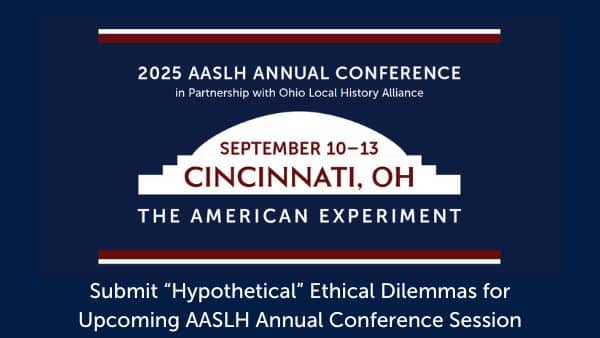
By Matt Arthur, AASLH Professional Development Manager
For much of the time I worked in museum interpretation, I felt like I was my own biggest hinderance to working with the public. I have Tourette’s syndrome, so it is pretty much guaranteed that during the course of the day I will have a tic of some sort. My head will pull hard to the left, an arm will fly out (potentially launching whatever I was holding), and I may bark or squawk. These tics aren’t quiet or subtle and I struggled to know what to do when they happened in front of visitors. There was a lot of apologizing and I feared shifting the focus to me and not the history I was interpreting.
Things changed for me when I began working hard on not offering excuses for being myself. Instead of feeling like I had to apologize for my tics, I moved on with my presentations. I realized visitors tended to fall into one of two camps: they either followed my lead and ignored the tics as well or they asked me if I was all right. To this latter group, I was able to take a moment to simply say, “Yeah, I have Tourette’s. I tic. It’s what I do.” I would then continue with my presentation. A good number of people, I noticed, would follow up with, “So… what would life have been like for you back then?”

Matt interpreting eighteenth-century life in a kitchen at Tryon Palace.
This was a great question and one I didn’t know the answer to. After about a week of getting the question repeatedly, I decided I needed to find out, not just for the visitors but because I was now genuinely interested in the experiences of eighteenth- and nineteenth-century people with Tourette’s. I started to research and the medical history proved to be interesting. Since Tourette’s was only named in 1885 by neurologist Georges Gilles de la Tourette, before that you have to search for people by their symptoms. I learned more about sources and treatments by reaching out to museums with medical collections, including the Mütter Museum and the National Museum of Health and Medicine, and those offering period medical demonstrations, like Colonial Williamsburg. Overwhelmingly, I was pointed to looking for evidence of and treatment for people who had “fits.” This would have been a broad term that covered modern diagnoses ranging from epilepsy to tic disorders. The leads I received and the conversations that I had allowed me to dig deeper into the period sources.
With the blessing of the head of the education department, I prepared a few of the cheaper and safer medicines used to treat these symptoms in the past to talk about in my presentations to visitors. When the conversation turned towards my tics, I was then ready to address, as a few visitors referred to it, “what was wrong with me.” I was able to give just a bit of what my diagnosis is and then tie it into life in the period for someone who had “fits.” When our site added a military camp on the grounds, I was able to tie in how individuals with regular fits were not typically allowed to participate in military service and regularly worked it into other medical discussions that arose, since period kitchens also were where some medicines would have been prepared. Treatments for fits even became a section of a webinar I gave on eighteenth-century medicines. Every time my Tourette’s and tics came up, it was well received, and I enjoyed being able to make some lesser known connections and share disability history where it might not have seemed easy or obvious on site.

I also appreciated helping to make a group of people who aren’t often thought of in the history books become a part of the average person’s understanding of the past.
This group actually includes some very famous figures. The eighteenth-century English writer Samuel Johnson published one of the most influential dictionaries in the English language in 1755. But he was also known for “odd gesticulations,” including muscular tics and sounds, leading later doctors and historians to agree he likely had Tourette’s. I appreciate that a man who, in any era, could have been socially ostracized or othered for those things beyond his control, made people recognize his brilliance and wit. After a traumatic brain injury as a teen, Harriet Tubman experienced “sleeping spells,” which modern doctors and historians think were some sort of combination of narcoleptic and epileptic episodes.
Today we remember Harriet as a fearless paragon of women’s and Black history, but she’s a disability history hero as well.
Although my experience sharing my personal situation was positive and empowering, museums should of course never force an individual who has a disability, health concern, or is neurodivergent to do the same. I was blessed with administration that saw my curiosity and willingness to do the work and be vulnerable without being forced to put myself on display. I would advocate the same for any person or site that is considering venturing into this kind of interpretation. Medical history, disability history, and neurodiversity are personal and potentially traumatic. No interpreter should be made to feel put on display “for the good of the museum” or to add diversity.
However, interpreters who have their lives affected in these ways who are willing to share this aspect of their life and tie it into their organization have a rare and potentially wonderful opportunity to give a voice to individuals who have been overlooked for centuries but were certainly fully part of history in their own rights. People who are different, disabled, and neurodivergent have always been here living their lives the best they can; it’s just a story that doesn’t get told often. Sharing with visitors that the past wasn’t all just “normal” folks, that humanity has always been this big, colorful kaleidoscope of experiences made me feel like I’d done something right, and powerful, and important.
Matt Arthur is AASLH’s Professional Development Manager. Prior to joining AASLH, he worked for fifteen years in the education department at Tryon Palace, a recreated eighteenth-century residence in eastern North Carolina. Contact Matt at [email protected].



